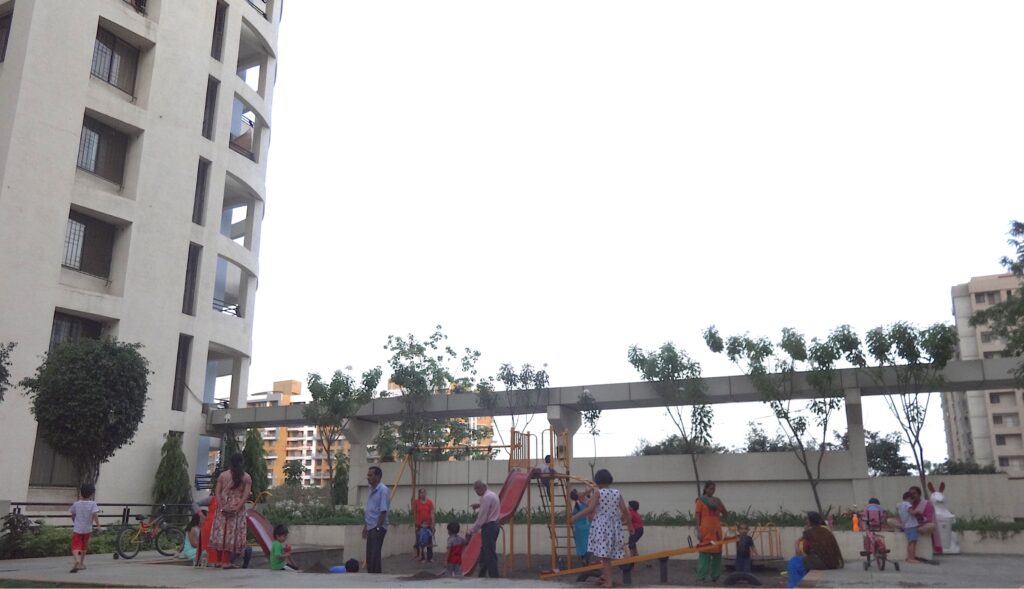My research work largely focuses on children and their caregivers’ lives in cities. I am interested in the actors and factors that shape the lives of children living in urban areas.
Listed below is an overview of my research so far:

Children’s Play in High-Rise Housing Developments
PH.D. RESEARCH PROJECT (2013 – 2020)
My doctoral research identified the combinations of spatial arrangements and physical features that influence young children’s access to play and the quality of their play opportunities in a heterogeneous sample of high-rise housing in India.
Using Bronfenbrenner’s Ecological Model of Human Development as a framework, I examined two large umbrellas that contribute to young children’s play opportunities in high-rise housing developments: (1) The play environment that is made available for children by developers and design professionals; and (2) Parents’ and caregivers’ ways of using the designated and undesignated spaces based on their own play values and beliefs.
Following a mixed-methods approach to research, I conducted a Baseline Study of 63 housing societies and case study research of seven varied high-rise housing environments in a fast-growing suburb of Pune metropolitan area. This approach supported the documentation and analysis of play opportunities for young children from middle-class families living in high-rise housing developments. Specifically, the case study research included in-depth field studies and interviews with developers, design professionals, city planners and Indian middle-class families.
Further, I supplemented the analysis of each case study by adapting Lefebvre’s Production of Space as an analytical framework to examine the conceptualized, actual and experienced spaces to represent the produced space of children’s play.
The outcomes of this doctoral research include the development of a comparative visual assessment chart, i.e., Array of Play Diversity, Design Principles, and Improvement Practices to help design professionals and developers provide an appropriate range of play elements, materials and surfaces to support young children’s play. Findings and analysis from this study generated knowledge to create better housing environments for children, thus, building a case for high-rise housing developments as an acceptable and a desired form of housing for families with young children.
You can access the full dissertation here
Play for “All” Children
2ND YEAR DOCTORAL RESEARCH PROJECT (2011 – 2012)
During my doctoral education, my second year research project introduced me to the world of children’s play. This research project explored play opportunities created in urban areas for children with different abilities. For this, I carried out fieldwork in Bengaluru, India and New York City, USA.
Using a qualitative methodology, my investigation included online desk reviews and fieldwork with three different organizations that create inclusive play spaces. Fieldwork included site visits to four inclusive play spaces (three in Bengaluru and one in New York City); and structured interviews with twelve key informant interviews.
Findings from this project revealed the simplicity of design interventions in the physical environment, yet at the same time acknowledged that the process of building play spaces for children with varied abilities is a complex one.
You can write to me for a copy of this research paper: sruthiatmakur@gmail.com
Safety in Public Spaces
Masters research project (2008 – 2010)
My Masters thesis is a study of public spaces with a focus on personal safety and human behavior in public spaces. With a review of literature in topics related to public spaces, safety standards, and behavioral research, my study aims to identify common ground or conflicts between people behavior in public spaces and safety standards of public spaces. The methodology includes detailed on-site analysis and various techniques of behavioral research of two plazas in a campus setting.
The first part of the thesis encompasses a literature review to understand origin of public space, importance of safety, and evolution of safety standards in the context of Crime Prevention Through Environmental Design (CPTED). The later part of this thesis is based on preliminary site investigations, which helped in identifying two public plazas on the Virginia Tech campus to provide a platform to conduct detailed fieldwork and help identify common grounds or conflicts between safety standards and human behavior. This research also aims to revise techniques of safety evaluation of public spaces based on human needs and behavior. The research is primarily qualitative in nature supported with a concise quantitative data analysis to ascertain participant demographics and social needs.
You can access the full thesis here

